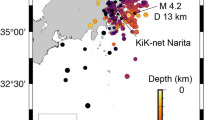Abstract
The depth and geometry of the potential sliding surface is the fundamental basis for evaluating the mechanism and performing mitigation measures of a landslide. The variation of shear wave velocity can directly reflect the characteristics of the strata structure in a landslide. For traditional methods (PS logging, surface exploration, H/V spectral ration and microtremor survey etc.), it is difficult to assure a large probing depth and high resolution at the same time. Joint observations were conducted using initiative-source multichannel analysis of surface wave (MASW) method and passive-source microtremor survey method (MSM) on the Xishan Village landslide located in Li County, Sichuan Province, China. Both frequency wave number method (F-K) and spatial auto correlation method (SPAC) were conducted to process the digital signal to analyze the shear wave velocity in the landslide, respectively. The Dual-source Surface Wave (DSSW) method was combined with MASW and MSM. The detected 2D profiles from the DSSW method showed that the landslide strata information was consistent with the borehole data. The results suggested that average depth of the potential sliding surface was about 50 m, of which the undulating shape was also clear. The boundary of the potential sliding surface was formed by weathered phyllite. It indicated that the DSSW method could assure both the exploration depth and enabling good resolution at the same time, which was an effective method to detect landslide structure and expected to be applied in survey of other geological hazards.











Similar content being viewed by others
References
Aki K (1957) Space and time spectra of stationary stochastic waves, with special reference to microtremors. Bull Earthquake Res inst tokyo Univ 35:415–456
Apostolidis P, Raptakis D, Roumelioti Z (2004) Determination of S-wave velocity structure using microtremors and spac method applied in Thessaloniki (Greece). Soil Dyn Earthq Eng 24(1):49–67
Asten MW (2006) On bias and noise in passive seismic data from finite circular array data processed using SPAC methods. Geophysics 71(6):V153–V162. doi:10.1190/1.2345054
Cui JW, Qiao S, Fan YX (1996) Application of transient Rayleigh surface wave prospecting method to engineering geology. Chinese Journal of Geotechnical Engineering 03(18):35–40 (In Chinese)
Danneels G, Bourdeau C, Torgoev I (2008) Geophysical investigation and dynamic modelling of unstable slopes: case-study of Kainama (Kyrgyzstan). Geophys J Int 175(1):17–34
Grandjean G, Gourry JC, Sanchez O, Bitri A, Garambois S (2011) Structural study of the Ballandaz landslide (French alps) using geophysical imagery. J Appl Geophys 75(3):531–542. doi:10.1016/j.jappgeo.2011.07.008
Hu JF, Duan YK, Hu YL, Fu ZW, Wen YB, Wu XP (1999) Inversion of shear-wave velocity structure in shallow soil from Rayleigh waves. Chin J Geophys 42(3):393–400 (In Chinese)
Jongmans D, Bièvre G, Renalier F, Schwartz S, Beaurez N, Orengo Y (2009) Geophysical investigation of a large landslide in glaciolacustrine clays in the Trièves area (French alps). Eng Geol 109(1–2):45–56. doi:10.1016/j.enggeo.2008.10.005
Ling SQ, Miwa S (2006) The evaluation of soil structures by surface wave prospecting method and microtremor survey method—2004 mid Niigata prefecture earthquake. In: Liu YZ (ed) A new technique on engineering geophysical method. Geological Publishing House, Beijing, pp. 80–85
Liu CL, Zheng Y, Ge C, Xiong X, Hsu HT (2013) Rupture process of the ms 7.0 Lushan earthquake. Science China Earth Sciences 56(7):1187–1192
Luo J (2015) The mechanism and controlling factors for the reactivation of the Xishan village landslide in Lixian county. Master degree thesis, Chengdu University of Technology, 2015
Maresca R, Galluzzo D, Del Pezzo E (2006) H/V spectral ratios and Array techniques applied to ambient noise recorded in the Colfiorito Basin, Central Italy. Bull Seismol Soc Am 96(2):490–505
Meric O, Garambois S, Malet JP, Cadet H, Gueguen P, Jongmans D (2007) Seismic noise-based methods for soft-rock landslide characterization. Bull Soc Geol Fr 178(2):137–148
Nakamura YA (1989) Method for dynamic characteristics estimation of subsurface using microtremor on the ground surface. Q Rep Railway Tech Res Inst 30:25–33
Okada H (2003) The microtremor survey method (translated by Koya Suto): geophysical monograph series, no. 12. Soc Explor Geophys
Okada H (2006) Theory of efficient array observations of microtremors with special reference to the SPAC method. Explor Geophys 37(1):73–85. doi:10.1071/EG06073
Park CB, Miller RD, Xia J (1999) Multi-channel analysis of surface waves. Geophysics 64(3):800–808
Wang ZD (2006) Essentials and recent advances of the surface wave exploration technique. Geophysical & Geochemical exploration 30(1):1–6 (In Chinese)
Xu PF, Li CJ, Ling SQ et al (2009) Mapping collapsed columns in coal mines utilizing microtremor survey methods. Chinese J, Geophys 52(7):1923–1930 (In Chinese)
Xu P, Ling S, Li C (2012) Mapping deeply-buried geothermal faults using microtremor array analysis. Geophys J Int 188(1):115–122
Acknowledgements
This study has been financially supported by the National Basic Research program of China (973 program, Grant No. 2013CB733201) and the Key Program of the Chinese Academy of Sciences (KZZD-EW-05-01)]. Special acknowledgments are to be given to the “Hundred Talents” program of Chinese Academy of Sciences for supporting the research work of the corresponding author. We are also grateful to the Sichuan Zhongcheng coal Geophysical Engineering Institute Co. Ltd. and Chinese seismic probe array center (CSPAC) for providing the experiment devices.
Author information
Authors and Affiliations
Corresponding author
Rights and permissions
About this article
Cite this article
Xu, Xq., Su, Lj., Zhang, Gd. et al. Analysis on shear wave velocity structure of a gravel landslide based on dual-source surface wave method. Landslides 14, 1127–1137 (2017). https://doi.org/10.1007/s10346-016-0780-9
Received:
Accepted:
Published:
Issue Date:
DOI: https://doi.org/10.1007/s10346-016-0780-9




